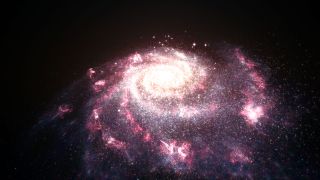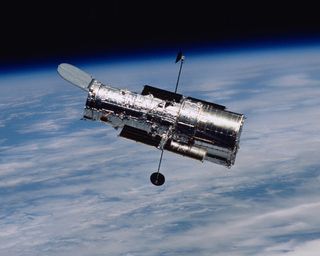Hubble Spies Cosmic Halos Around Starburst Galaxies

Star formation involves more than meets the eye. Huge "starbursts" that give birth to hundreds of millions of new stars at once within galaxies all over the universe seem to affect their host galaxies in surprising ways, a new study reveals.
Astronomers using the Hubble Space Telescope found that the extreme winds created by rapid star formation can be felt up to 650,000 light-years from the center of the galaxy, much farther than previously thought, Hubble mission scientists said in a statement today (April 25). Winds from the starbursts actually form halos that reach about 20 times farther into space than the visible size of the galaxy.
"The extended material around galaxies is hard to study, as it’s so faint," study team member Vivienne Wild of the University of St. Andrews. "But it’s important — these envelopes of cool gas hold vital clues about how galaxies grow, process mass and energy, and finally die. We’re exploring a new frontier in galaxy evolution!" [Hubble's Most Amazing Discoveries]
The scientists were able to create a stunning video of the starburst galaxy's gas halo using the observations by Hubble's powerful Cosmic Origins Spectrograph, or COS.
"Hubble is the only observatory that can carry out the observations necessary for a study like this," said the study's lead author Sanchayeeta Borthakur of Johns Hopkins University. "We needed a space-based telescope to probe the hot gas, and the only instrument capable of measuring the extended envelopes of galaxies is COS."
Borthakur's team examined 20 galaxies in all different states of star formation nearby the Milky Way. They found that ionized gas — gas that has been excited by the stellar wind — only surrounds galaxies going through starburst periods.
The ionized gas surrounding the galaxies regulates "any future star formation," officials said in the press release. The ionization causes cooler gas to fall, limiting the availability of the gas used to form new stars.
Get the Space.com Newsletter
Breaking space news, the latest updates on rocket launches, skywatching events and more!
"Starbursts are important phenomena — they not only dictate the future evolution of a single galaxy, but also influence the cycle of matter and energy in the Universe as a whole," study team member Timothy Heckman, an astronomer Johns Hopkins University said in a statement. "The envelopes of galaxies are the interface between galaxies and the rest of the Universe — and we’re just beginning to fully explore the processes at work within them."

The Hubble Space Telescope celebrated its 23rd anniversary in orbit this week. The iconic telescope is operated by NASA and the European Space Agency. It launched into space from the space shuttle Discovery on April 24, 1990, and could remain operational until 2020.
Its successor — the $8.8 billion James Webb Space Telescope — is scheduled for launch in 2018. Scientists working with both telescopes hope that the two space telescopes will be functioning on orbit at the same time before Hubble is retired.
The new research will appear in the May 1 issue of The Astrophysical Journal.
Follow Miriam Kramer on Twitter and Google+. Follow us on Twitter, Facebook and Google+. Original article on SPACE.com.
Join our Space Forums to keep talking space on the latest missions, night sky and more! And if you have a news tip, correction or comment, let us know at: community@space.com.

Miriam Kramer joined Space.com as a Staff Writer in December 2012. Since then, she has floated in weightlessness on a zero-gravity flight, felt the pull of 4-Gs in a trainer aircraft and watched rockets soar into space from Florida and Virginia. She also served as Space.com's lead space entertainment reporter, and enjoys all aspects of space news, astronomy and commercial spaceflight. Miriam has also presented space stories during live interviews with Fox News and other TV and radio outlets. She originally hails from Knoxville, Tennessee where she and her family would take trips to dark spots on the outskirts of town to watch meteor showers every year. She loves to travel and one day hopes to see the northern lights in person. Miriam is currently a space reporter with Axios, writing the Axios Space newsletter. You can follow Miriam on Twitter.
